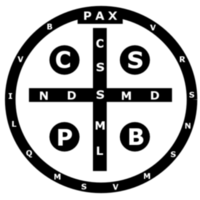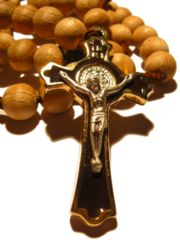
Saint Benedict Medal
Encyclopedia

Sacramentals
Sacramentals are material objects, things or actions set apart or blessed by the Roman Catholic Church, the Orthodox Churches, the Anglican Churches, and Old Catholic Churches to manifest the respect due to the Sacraments, and so to excite good thoughts and to increase devotion, and through these...
medal
Medal
A medal, or medallion, is generally a circular object that has been sculpted, molded, cast, struck, stamped, or some way rendered with an insignia, portrait, or other artistic rendering. A medal may be awarded to a person or organization as a form of recognition for athletic, military, scientific,...
containing symbols and text related to the life of Saint Benedict of Nursia
Benedict of Nursia
Saint Benedict of Nursia is a Christian saint, honored by the Roman Catholic Church as the patron saint of Europe and students.Benedict founded twelve communities for monks at Subiaco, about to the east of Rome, before moving to Monte Cassino in the mountains of southern Italy. There is no...
. In use since at least the seventeenth century, it is used to ward off spiritual and physical dangers, especially those related to witchcraft, poison, and temptation. Sometimes carried as part of the rosary
Rosary
The rosary or "garland of roses" is a traditional Catholic devotion. The term denotes the prayer beads used to count the series of prayers that make up the rosary...
, it is also found individually.
History
The exact time and date of the making of the first Saint Benedict Medal are not clear. Saint Vincent de Paul, who died in 1660, appears to have been acquainted with the Medal and the Sisters of CharitySisters of Charity
Many religious communities have the term Sisters of Charity as part of their name. The rule of Saint Vincent for the Daughters of Charity has been adopted and adapted by at least sixty founders of religious orders around the world in the subsequent centuries....
founded by him have worn it attached to their rosary beads, and for many years it was made in France for them alone.
At some point there were letters found on the back of the medal, which remained a mystery until a manuscript dating back to 1415 was found at Metten Abbey
Metten Abbey
Metten Abbey, or St. Michael's Abbey at Metten is a house of the Benedictine Order in Metten near Deggendorf, situated between the fringes of the Bavarian Forest and the valley of the Danube, in Bavaria in Germany.The abbey was founded in 766 by Gamelbert of Michaelsbuch...
in Bavaria
Bavaria
Bavaria, formally the Free State of Bavaria is a state of Germany, located in the southeast of Germany. With an area of , it is the largest state by area, forming almost 20% of the total land area of Germany...
in 1647. The manuscript contains the first recorded use of the exorcism
Exorcism
Exorcism is the religious practice of evicting demons or other spiritual entities from a person or place which they are believed to have possessed...
formula Vade retro satana
Vade retro satana
Vade retro satana is a Medieval Catholic formula for exorcism, recorded in a 1415 manuscript found in the Benedictine Metten Abbey in Bavaria and its origin is traditionally associated with the Benedictines....
("Step back, Satan"), and the letters were found to correspond to this phrase.
The medal was formally approved by Pope Benedict XIV
Pope Benedict XIV
Pope Benedict XIV , born Prospero Lorenzo Lambertini, was Pope from 17 August 1740 to 3 May 1758.-Life:...
in 1741 and the Jubliee medal was struck in 1880, in remembrance of the 1400th anniversary of St. Benedict’s birth. The initials of the Vade retro satana formula have been found on Saint Benedict Medals at least since 1780.
The medal’s symbolism

Sign of the cross
The Sign of the Cross , or crossing oneself, is a ritual hand motion made by members of many branches of Christianity, often accompanied by spoken or mental recitation of a trinitarian formula....
over it (and a raven carried away a poisoned loaf of bread). Above the cup are the words Crux sancti patris Benedicti ("The Cross of [our] Holy Father Benedict"). Surrounding the figure of Saint Benedict are the words Eius in obitu nostro praesentia muniamur! ("May we be strengthened by his presence in the hour of our death"), since he was always regarded by the Benedictines as the patron of a happy death.
On the back is a cross, containing the letters C S S M L - N D S M D, initials of the words Crux sacra sit mihi lux! Non draco sit mihi dux! ("May the holy cross be my light! May the dragon never be my overlord!").The large C S P B stand for Crux Sancti Patris Benedicti ("The Cross of [our] Holy Father Benedict"). Surrounding the back of the medal are the letters V R S N S M V - S M Q L I V B, in reference to Vade retro satana: Vade retro Satana! Nunquam suade mihi vana! Sunt mala quae libas. Ipse venena bibas! ("Begone Satan! Never tempt me with your vanities! What you offer me is evil. Drink the poison yourself!") and finally, located at the top is the word PAX which means "peace".
Use of the medal

Exorcism
Exorcism is the religious practice of evicting demons or other spiritual entities from a person or place which they are believed to have possessed...
s but they can use the Saint Benedict Medal, holy water
Holy water
Holy water is water that, in Catholicism, Anglicanism, Eastern Orthodoxy, Lutheranism, Oriental Orthodoxy, and some other churches, has been sanctified by a priest for the purpose of baptism, the blessing of persons, places, and objects; or as a means of repelling evil.The use for baptism and...
, the crucifix
Crucifix
A crucifix is an independent image of Jesus on the cross with a representation of Jesus' body, referred to in English as the corpus , as distinct from a cross with no body....
, and other sacramentals to ward off evil. The Saint Benedict Medal in the middle of a Celtic cross is very rare and powerful against evil spirits.
This medal is used in numerous ways:
- on a chain around the neck;
- attached to one's rosary;
- kept in one's pocket or purse;
- placed in one's car or home;
- placed in the foundation of a building;
- placed in the center of a cross.
It is supposed to be effective in many ways:
- to destroy witchcraft and all other diabolical and haunting influences;
- to impart protection to persons tempted, deluded, or tormented by evil spirits;
- to obtain the conversion of sinners into the Catholic Church, especially when they are in danger of death;
- to serve as an armor against temptation;
- to destroy the effects of poison;
- to secure a timely and healthy birth for children;
- to afford protection against storms and lightning;
- to serve as an efficacious remedy for bodily afflictions and a means of protection against contagious diseases.
Blessing of the medal
Medals of Saint Benedict are sacramentalsSacramentals
Sacramentals are material objects, things or actions set apart or blessed by the Roman Catholic Church, the Orthodox Churches, the Anglican Churches, and Old Catholic Churches to manifest the respect due to the Sacraments, and so to excite good thoughts and to increase devotion, and through these...
that may be blessed
Blessing
A blessing, is the infusion of something with holiness, spiritual redemption, divine will, or one's hope or approval.- Etymology and Germanic paganism :...
legitimately by any priest
Priest
A priest is a person authorized to perform the sacred rites of a religion, especially as a mediatory agent between humans and deities. They also have the authority or power to administer religious rites; in particular, rites of sacrifice to, and propitiation of, a deity or deities...
or deacon
Deacon
Deacon is a ministry in the Christian Church that is generally associated with service of some kind, but which varies among theological and denominational traditions...
, not necessarily a Benedictine
Benedictine
Benedictine refers to the spirituality and consecrated life in accordance with the Rule of St Benedict, written by Benedict of Nursia in the sixth century for the cenobitic communities he founded in central Italy. The most notable of these is Monte Cassino, the first monastery founded by Benedict...
.
The following English form may be used:
The medal is then sprinkled with holy water.

